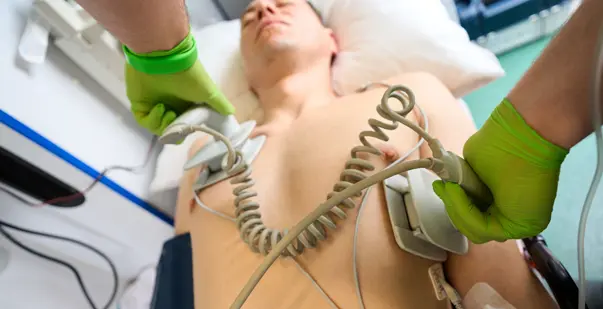Table of content(s)
- Introduction
- Cardioversion vs. defibrillation: an overview
- What are the types of cardioversion?
- What are the risks associated with cardioversion?
- What are the types of defibrillators?
- What are the risks associated with defibrillation?
- Conclusion
Cardioversion and defibrillation occur in healthy hearts and are short-lived. Serious arrhythmias are prolonged and can be dangerous. This can disrupt the functioning of the heart, leading to sudden cardiac arrest.
On the other hand, cardioversion is a planned procedure that corrects arrhythmias, such as atrial fibrillation. It uses electric shocks or medication. These are effective in managing heart rhythm disorders. Let us understand the differences between cardioversion and defibrillation.
Master ACLS Now
Get ACLS certified with confidence
Understanding cardioversion
Cardioversion is a medical procedure administered to patients who have arrhythmia. This is beneficial for changing their heartbeat pattern. It administers synchronized electric shocks to treat an abnormal heart rhythm, such as atrial fibrillation or atrial flutter. Cardioversion uses electric current passing through electrodes placed on the patient’s chest.
You can also utilize medication, known as chemical cardioversion or pharmacologic cardioversion. Electrical cardioversion is a planned procedure carried out in a hospital. It’s more appropriate for patients with specific arrhythmias, which require a shock delivered at particular phases of the electrical cycle in the heart.
Understanding defibrillation
Defibrillation is beneficial during cardiac arrest, especially when you cannot find a pulse. It is also beneficial for specific types of arrhythmia. An electrical shock from an AED is a stronger shock as compared to the ones delivered during cardioversion. It helps in resetting the signals and pumping of the heart.
When do you defibrillate? In a healthy heart, the cells send out electrical impulses, which create a chain reaction of contractions. It moves the blood around. Ventricular fibrillation, or ventricular tachycardia, leads to chaotic electrical impulses in the heart, depending on the specificity of pulse dysfunction. So, one cannot speak about the coordinated contraction of heart muscle.
A direct shock of electrical current’ from the defibrillator affects most of the heart muscle and records the cessation of the arrhythmia. When a patient gets a shock from the AED, it flows from the electrode pads and right through the heart of the patient. The shocks delivered by the defibrillator increase the patient’s heart muscle’s voltage to zero. This halts the ineffective rhythm, commonly referred to as defibrillation.
After this, there is a brief period where the electrical signals in the heart pause prior to reestablishing a normal heartbeat.
Once the heart has been defibrillated, it goes back to sinus rhythm. It starts recirculating oxygen-rich blood throughout the body. The skin color may return to normal, and the person will start breathing normally.
Read more: Identifying and Treating Atrial Fibrillation (AFib or AF)
What are the types of cardioversion?
Cardioversion restores a normal heart rhythm in patients with specific types of abnormal heartbeats. Here are two types of cardioversion:
- Electrical cardioversion: This is known as direct current cardioversion. It delivers a controlled electric shock to the heart and restores the rhythm. The procedure is performed under sedation and ensures comfort. Electrical cardioversion is beneficial for atrial fibrillation and specific kinds of supraventricular tachycardia.
- Pharmacologic cardioversion: Antiarrhythmic medications convert the heart to a normal rhythm. You can administer these orally or intravenously. This affects the electrical signals in the heart. You can consider pharmacologic cardioversion with less severe arrhythmias.
Both types of cardioversion help restore heart rhythm. However, the choice depends on the medical condition of the patient.
What are the risks associated with cardioversion?
Here are certain risks associated with cardioversion:
- Blood clotting issues: Blood clots can form as a result of abnormal heart rhythms. Cardioversion may remove them. This can cause several other complications, such as strokes.
- It can lead to the development of future arrhythmias.
- It may not work and may need further interventions.
What are the types of defibrillators?
Here are the different types of external defibrillators:
Automated external defibrillators: These are machines that treat cardiac arrest. It sends an electric shock to the heart of a person in cardiac arrest. Furthermore, it restores the heart’s rhythm. These are user-friendly, and hence anybody can use them.
There are two types of AEDs:
- Fully automatic AED: It analyzes the rhythm of the heart. If a shock is warranted, then the AED will say so. Hence, instruct bystanders to stand back with no physical contact with the victim. Deliver a shock on its own.
- Semi-automatic AED: It analyzes the heart, and if a shock is warranted, then the AED will say so. Then it instructs the respondent to press the shock button and delivers a shock.
What are the risks associated with defibrillation?
Every minute a person does not receive defibrillation, their survival chances drop significantly. The risks associated include:
- Cardiac arrhythmias
- Skin burns
- Damaged cardiac and adjacent tissue
Read more: VF and pulseless VT
Conclusion
Understanding cardioversion and defibrillation is crucial to treating cardiovascular emergencies effectively. A minor atrial flutter needs treatment to avoid blood clotting. If you have severe tachycardia, your healthcare provider may talk with you about cardioversion. AED is an effective treatment when used promptly. So who is the winner in analyzing defibrillation vs cardioversion? Cardioversion and defibrillation are essential procedures to restore normal heart rhythms. They suit differently to distinct situations.







